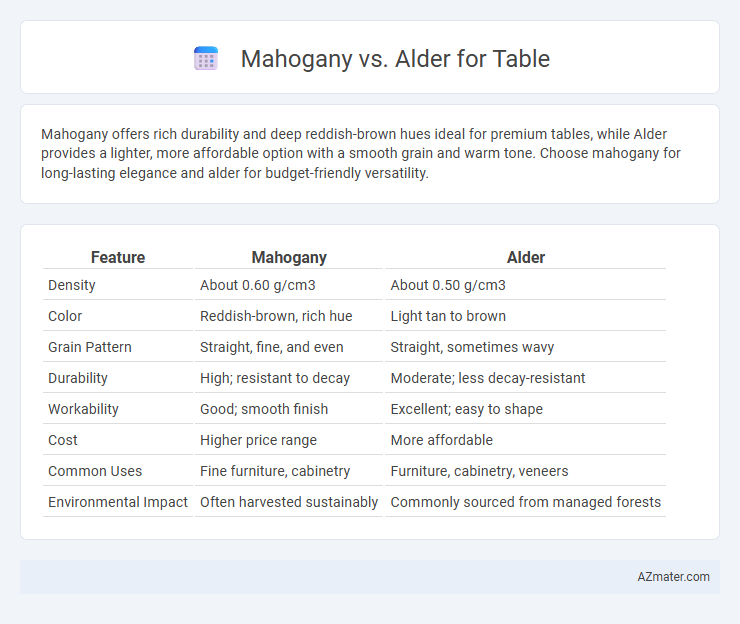Mahogany offers rich durability and deep reddish-brown hues ideal for premium tables, while Alder provides a lighter, more affordable option with a smooth grain and warm tone. Choose mahogany for long-lasting elegance and alder for budget-friendly versatility.
Table of Comparison
| Feature | Mahogany | Alder |
|---|---|---|
| Density | About 0.60 g/cm3 | About 0.50 g/cm3 |
| Color | Reddish-brown, rich hue | Light tan to brown |
| Grain Pattern | Straight, fine, and even | Straight, sometimes wavy |
| Durability | High; resistant to decay | Moderate; less decay-resistant |
| Workability | Good; smooth finish | Excellent; easy to shape |
| Cost | Higher price range | More affordable |
| Common Uses | Fine furniture, cabinetry | Furniture, cabinetry, veneers |
| Environmental Impact | Often harvested sustainably | Commonly sourced from managed forests |
Introduction to Mahogany and Alder Wood
Mahogany, a dense hardwood known for its rich reddish-brown color and fine grain, offers exceptional durability and resistance to wear, making it ideal for high-quality tables. Alder wood, a softer hardwood with a light tan to reddish-brown hue, features a smooth texture and uniform grain that is easy to work with and takes finishes well. Both woods provide distinct aesthetic and functional qualities, with mahogany favored for luxury and strength while alder is prized for affordability and ease of customization.
Physical Appearance and Grain Patterns
Mahogany features a rich, reddish-brown color with a smooth, straight grain pattern that gives tables a classic, elegant look. Alder wood offers a lighter, warm tan to reddish-brown hue with a more varied, often wavy or curly grain, creating a rustic and inviting appearance. The dense, fine grain of mahogany contrasts with alder's softer texture, influencing both the visual appeal and finishing techniques for tables.
Durability and Strength Comparison
Mahogany is known for its exceptional durability and resistance to wear, making it a popular choice for high-quality tables that require long-lasting strength. Alder, while softer and less dense than mahogany, offers moderate durability with a fine, even grain that is easier to work with and repair. For tables subjected to heavy use, mahogany provides superior resilience and structural integrity compared to alder.
Weight and Workability of Each Wood
Mahogany is a dense hardwood with an average weight of about 40-50 lbs per cubic foot, providing excellent durability but making it heavier and more challenging to handle when crafting tables. Alder is significantly lighter, averaging 28-33 lbs per cubic foot, and is known for its exceptional workability, allowing for smooth shaping and detailed carving with ease. The choice between mahogany and alder for table construction often hinges on balancing mahogany's robust weight and strength against alder's lighter, more manageable nature and superior ease of machining.
Color and Aging Over Time
Mahogany features a rich, deep reddish-brown color that darkens and develops a warm patina with age, enhancing its luxurious appearance. Alder offers a lighter, creamy to reddish-brown tone that tends to mellow into a subtle golden hue over time, maintaining a soft and natural look. Both woods age gracefully, but mahogany's color transformation is more pronounced, making it ideal for achieving a classic, elegant table finish.
Cost and Availability
Mahogany tables often command higher prices due to the wood's rich durability and limited supply, making it less accessible for budget-conscious buyers. Alder wood offers a more affordable alternative with widespread availability, providing a cost-effective option without sacrificing quality. The choice between mahogany and alder primarily hinges on budget constraints and the desired balance between investment and material accessibility.
Environmental Impact and Sustainability
Mahogany, often sourced from tropical rainforests, raises significant sustainability concerns due to slow growth rates and deforestation risks, whereas Alder is a fast-growing hardwood commonly found in managed North American forests, promoting better sustainability practices. The environmental impact of mahogany includes habitat loss and higher carbon emissions from longer cultivation periods, while alder offers lower ecological footprints with quicker regeneration and responsible harvesting methods. Choosing alder supports sustainable forestry initiatives and reduces demand on endangered mahogany species, making it a more eco-friendly option for table construction.
Best Table Designs for Mahogany vs. Alder
Mahogany tables showcase rich, deep hues and fine grain patterns that enhance traditional and elegant table designs, making them ideal for formal dining rooms and classic settings. Alder wood, with its lighter color and smooth texture, suits casual and rustic table designs, providing warmth and versatility for farmhouse or contemporary styles. Both woods offer durability, but mahogany's dense hardwood structure supports intricate carving and elaborate detailing, while alder's softness allows for simpler, lighter constructions.
Maintenance and Longevity
Mahogany tables offer superior durability and resistance to wear, making them low-maintenance with periodic polishing to preserve their rich color. Alder wood tables require more frequent care due to their softer, more porous nature, including regular sealing to prevent moisture damage and stains. Longevity-wise, mahogany typically outlasts alder, maintaining structural integrity and appearance for decades with proper care.
Final Recommendation: Which is Better for Tables?
Mahogany offers superior durability, rich color, and fine grain texture, making it ideal for high-end, long-lasting tables that enhance luxury interiors. Alder, being softer and more affordable, suits casual or painted tables but lacks the hardness needed for heavy daily use. For tables prioritizing strength, elegance, and longevity, mahogany is the better choice.

Infographic: Mahogany vs Alder for Table
 azmater.com
azmater.com